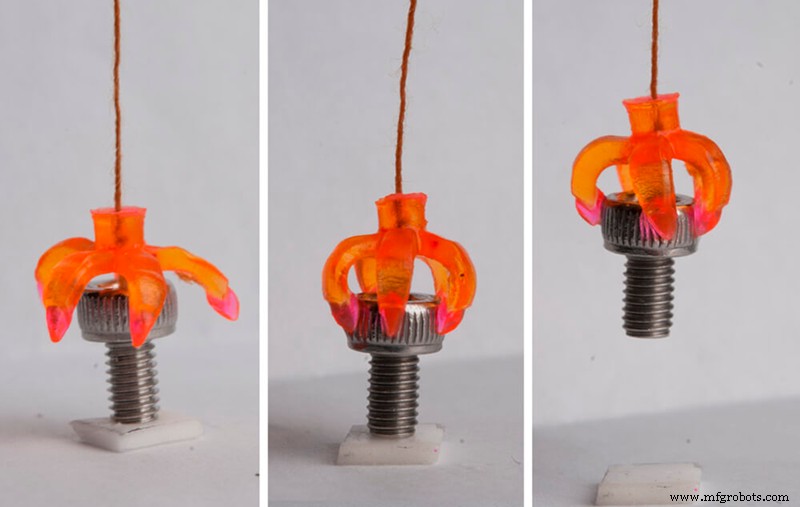4D 打印:3D 打印的未来
如果管道可以自动修复会怎么样 如果它们破裂或破损,或者衣服可能会根据天气或用户正在进行的活动而改变 ?可自行组装的家具、可适应生长的假肢……这些只是 4D 打印技术设想实现的一些可能应用。

图片 1:修改其形状的 4D 打印爪。资料来源:Sculpteo。
3D打印 已经存在了将近 30 年,虽然它仍在研究、发现新材料和应用,但已经出现了 4D 等新技术。
在麻省理工学院自组装实验室 ,他们开发了一个项目,其中 4D 打印是其中的一部分。它的目的是结合技术和设计发明可编程材料 和自组装技术,旨在重塑建筑、制造、产品组装和性能。同时,威斯研究所的一项研究 (哈佛大学的一部分)已成功打印出一种物体,当它与水接触时会改变形状 e,导致其两端开花。他们开发了一种基于自然结构(例如植物)的材料,在打印过程中将其注入纤维素纤维。
视频 1:变形架构。资料来源:哈佛大学。
什么是 4D 打印?
受自组装原理的启发,4D 打印是 3D 打印对象在外部能量输入(例如温度、光线或其他环境刺激)的影响下转变为不同结构的过程。 也就是说,通过 3D 技术获得一个物体,由于其制造材料的特性,能够在受到环境刺激时发生变化。
这正是不同之处 3D 和 4D 技术之间的差异:对象在没有人为干预的情况下随时间变化的能力。
使用的材料
4D 打印的关键与其说是过程 ,基于熟悉的 3D 打印机, 但材料。 由于这是一项相当新的技术,可用的材料不像标准 3D 打印所使用的材料那样多样化。不过,也有一些非常有趣的。
SMP(形状记忆聚合物)
在室温下保持刚性并在达到玻璃化转变点时提供特殊性能的聚合物。一个例子是 Convena 的 TPU SMP:具有基于 TPU 成分的 4D 灯丝 (热塑性聚氨酯),允许进行后处理修改 3D 打印部件的形状。 由于其特殊的成分和形状记忆聚合物技术, 用这种灯丝打印的部件可以手动修改,使它们获得另一种形状并随着时间的推移保持它。
使用 SMP TPU 灯丝修改 3D 打印部件形状的过程包括将 3D 打印部件放入装有热水的容器中,直到达到其玻璃化转变温度。此时,零件变软,用户可以轻松修改其形状。冷却后,零件会保持获得的形状并保持稳定。此外,使用 SMP TPU 丝材 3D 打印的部件可以通过逆向过程恢复到原来的形状。也就是说,再次达到了材料的玻璃化转变温度。
LCE(液晶弹性体)
它们含有液晶 对热敏感。 通过控制它们的方向,可以对所需的形状进行编程: 在温度的作用下,材料会按照规定的代码松弛和变形。
水凝胶
主要由水组成的聚合物链 ,特别用于光固化过程。后者因其生物相容性而专注于医疗领域。
此外,一些 4D 打印工艺可以使用各种材料,主要是添加到 SMP 或水凝胶中的木材或碳等复合材料。这导致对象具有刚性和可移动区域。
应用
Given the many advantages of such intelligent materials, the applications of 4D printing are innumerable.
Construction
The construction of climate-adapted structures such as bridges, shelters or other facilities would be a huge step forward in this field. 4D bricks capable of modifying walls and roofs to suit the environment would allow indoor conditions to be modified and improved.
Video 2:Programmable wood. Source:Self-Assembly Lab, MIT.
Medicine
In this case, 4D printing offers the possibility to create tailor-made, intelligent and evolving devices. For example, by 4D printing an implant, its condition and viability could be more easily monitored once it is integrated into the patient.
This concept is applicable to all regenerative medicine and the fabrication of cellular structures. 4D printing would allow cells to adapt to the human body depending on its temperature, 例如。 If we talk about medicines, it would be possible, for example, to print a device that would release the required dose depending on the patient's body temperature.
Transport
A few months ago, BMW and MIT presented their inflatable material, which changes shape and size under the effect of air pulses. The applications are very interesting, as in the future we could have tyres that can repair themselves in case of a puncture or adapt to the terrain and weather conditions of the environment.
In the case of the aircraft industry, a 4D printed component could react to atmospheric pressure or temperature changes and thus change its function. Airbus is currently working on such developments, as these components could replace hinges and hydraulic actuators, significantly lightening the devices . In addition, it is also working on the development of heat-reactive materials to cool its aircraft engines.
Raúl Pulido Casillas, a Spanish engineer, has created a 4D-printed smart fabric for NASA. The metallic mesh, made of silver pieces joined together, has thermal regulation programmed into its print. In other words, not only its shape has been printed, but also the function of the materials. As it is able to reflect heat on the outside and retain it on the inside, it could be an ideal element for making astronaut suits or covering spacecraft.
Fashion
In the textile industry, 4D printing is also finding its place. The possibility of printing shoes that adapt to movement, impact, temperature and atmospheric pressure is a possibility. The US military has already made a foray into this field and is testing uniforms that change colour depending on the environment, or that regulate perspiration depending on the soldier's pulse or the ambient temperature.
Although we are still in its infancy, it is certain that 4D technology will revolutionise the manufacture and nature of objects over the next few years, just as 3D printing did in its day.
3D打印


